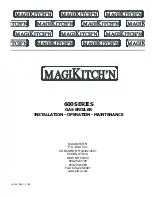
Instructions for Use, Installation and Servicing ecoMAX pro
12
NOTE:
A higher initial design pressure requires a larger
volume expansion vessel.
The charge pressure must not be less than the
static head of the system, that is, the height of the
highest point of the system above the expansion vessel.
5.9.3 Pressure Gauge
A pressure gauge with a set pointer and covering at least
0 to 4 bar (0 to 60 lb/in2) shall be fitted permanently to
the system in a position where it can be seen when
filling the system.
5.9.4 Domestic Hot Water Cylinder
The domestic hot water cylinder must be of the double
feed fully indirect coil type. It must be suitable for
working at a gauge pressure of 0.35 bar above the safety
valve setting.
5.9.5 Water Makeup
Provision should be made for replacing water loss from
the system using a make up bottle mounted in a position
higher than the top point of the system, connected
through a non-return valve to the return side of either the
heating circuit or the hot water cylinder.
Alternatively, provision for make up water should be
made using a proprietary filling loop.
5.9.6 Filling a Sealed Water System
Provision for filling the system at low level must be made.
This can be achieved by the use of a proprietary filling
loop.
5.9 Sealed water Systems
The installation must comply with the appropriate
requirements of the current issue of BS4814, BS5449,
BS6759, BS6798 and BS7074 Part 1 and 2. For IE your
attention is drawn to the current edition of IS 813.
See Fig. 5.4 for a suggested layout.
5.9.1 Safety Valve
A safety valve must be fitted to a sealed system.
It shall be preset, non-adjustable with a lift pressure of
3-bar, incorporating seating of a resilient material, a test
device and a connection for drain.
The safety valve discharge pipe must be routed to
outside the building, must not discharge above an
entrance or window or any type of public access area, be
clear of any electrical fittings and positioned so that any
discharge can be seen.
5.9.2 Expansion Vessel
A diaphragm type expansion vessel, conforming to the
current issue of BS4814 (see also BS7074 Part 1 and 2).
For IE the current edition of IS 813, must be connected
at a point close to the inlet side of the circulating pump,
see the diagrammatic layout, Fig. 5.4. unless laid down
differently by the manufacturer.
The expansion vessel volume depends on the total water
system volume and the initial system design pressure.
For any system an accurate calculation of vessel size is
given in the current issue of BS5449 and BS7074 Part 1.
Example: For an initial design pressure of 0.7 bar, the
minimum total vessel volume required is 0.063 x Total
System Volume.
Fig 5.4
12628
5 Water system













































